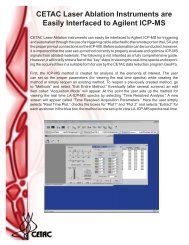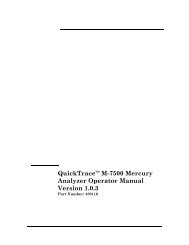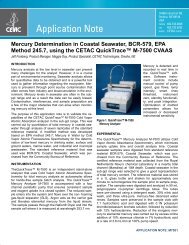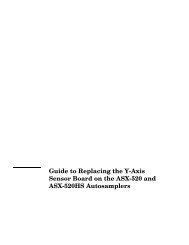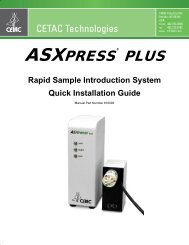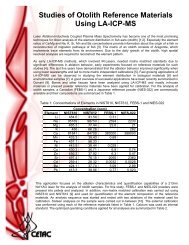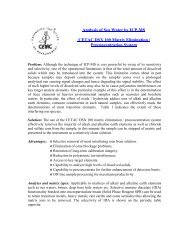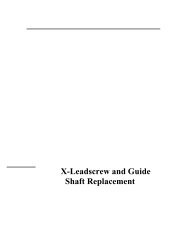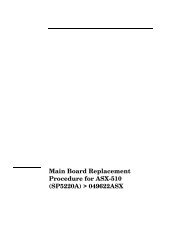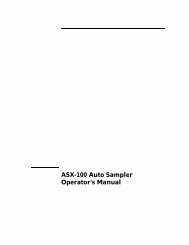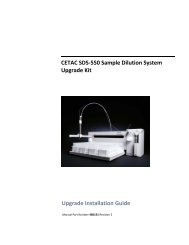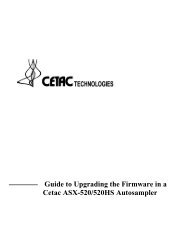CETAC M-7600 Mercury Analyzer Operator's Manual
CETAC M-7600 Mercury Analyzer Operator's Manual
CETAC M-7600 Mercury Analyzer Operator's Manual
Create successful ePaper yourself
Turn your PDF publications into a flip-book with our unique Google optimized e-Paper software.
Operator’s <strong>Manual</strong><br />
Chapter 4: Using the <strong>Analyzer</strong><br />
Ultimately, the gas stream (carrier gas and Hg 0 ) exits the sample cell (15) and<br />
is exhausted to a solid KMnO 4 trap (16) where Hg 0 is absorbed, and clean<br />
carrier gas passes to the lab atmosphere.<br />
Dryer Cartridge<br />
The mercury analyzer uses a Perma Pure ® DuPont Nafion ® -based dryer<br />
cartridge. Dryer cartridges typically last three to six months.<br />
The dryer cartridge contains Perma Pure ® dryer tubing which is made with a<br />
tubular DuPont Nafion ® membrane. The Nafion ® tubing is housed within an<br />
outer tube and coiled inside the cartridge. The argon or nitrogen carrier gas<br />
containing mercury and water vapor is swept along the inner Nafion ®<br />
membrane, allowing water vapor to permeate the membrane selectively,<br />
whereas the membrane is not permeable to mercury vapor. On the “waste” side<br />
of the membrane, a counter gas flow, split from the carrier gas supply,<br />
selectively sweeps the water vapor out of the system, whereas non-permeating<br />
mercury vapor proceeds to the sample cell.<br />
The Perma Pure ® dryer cartridge and associated plumbing is already preinstalled<br />
in your new QuickTrace M-<strong>7600</strong> factory shipment. No further<br />
installation is required.<br />
Optics and Cold Vapor AAS<br />
Refer again to Figure 4-1 on page 76 to trace the optical path of the<br />
QuickTrace M-<strong>7600</strong>. The Cold Vapor AAS (Atomic Absorption Spectrometry)<br />
process within the sample cell begins with a low pressure, high frequency,<br />
thermally stabilized, electro-optically regulated Hg vapor lamp, which<br />
produces the Hg emission spectrum. Emitted light is collimated (L 1) and<br />
projected in two parallel, isolated beams one each through the reference and<br />
sample cells. Absorbance of 253.7nm radiation by Hg 0 vapor (derived from the<br />
chemically reduced sample and GLS) occurs only in the sample cell. P is<br />
thereby decreased, relative to P 0.<br />
Light from the cells enter the binocular camera, where both collimated beams<br />
are independently focused (L 2) and filtered (F) before reaching the Charged<br />
Coupled Device (CCD) detector. Narrow band 254 +/- 2nm interference filters<br />
(F) remove all radiation but the strong 253.7 nm Hg 0 “resonance line” from<br />
both the sample (P) and reference (P 0) beams. By a photovoltaic effect, the CCD<br />
converts the light beams into electrical signals, proportional to radiant power<br />
(P and P 0). These outputs are processed to yield an electrical signal<br />
proportional to optical absorbance (Abs = -log (P/P 0)).<br />
Software<br />
In the host computer, the sample absorbance value is drift corrected, blank<br />
subtracted, if through blank is desired. The absorbance value is then measured<br />
against a calibration curve derived from previously obtained absorbance<br />
values of calibration standards.<br />
The QuickTrace software operates under a Windows environment. The<br />
QuickTrace software provides complete instrument, autosampler control.<br />
The QuickTrace software also provides a variety of EPA compliant quality<br />
control functions, display features, report generation and diagnostic routines.<br />
78



